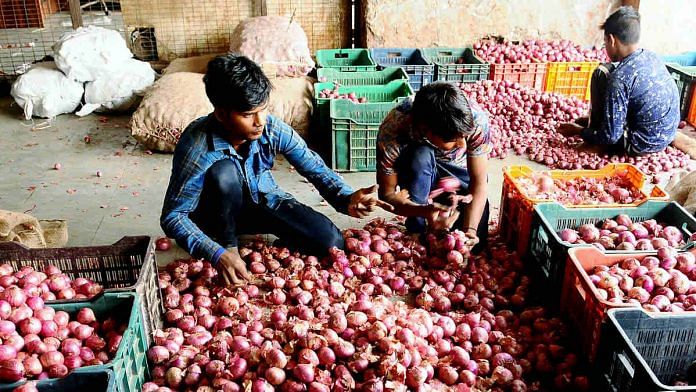It is that time of the year again. On the one hand, the domestic onion crop has started coming in, and on the other, the Metals and Minerals Trading Corporation of India (MMTC) has been asked to import 1.2 lakh tonnes of onions to bring down skyrocketing prices.
This is not the first time this is happening. Onion is a seasonal crop, and the shortage of onions in the offseason leads to a spike in prices in September to November every year. Sometimes, the spike is worse than usual. Since private traders cannot freely import onions, the problem does not come to light until prices go sky high and make bad press.
This prompts politicians to respond. The consequences can be to create even more distortions than we began with.
Also read: Rising onion prices are fuelling India’s inflation, not low interest rates
Import process and storage
First of all, onion imports from China, Russia and Egypt are likely to reach too late. The domestic onion crop would already be hitting the market before, or at the same time as, imports reach Indian shores. Even now, prices of onion for farmers have already started dropping. Farmers are distressed at having to sell onions for Rs 8 per kg.
Onion-buying teams are currently being sent to Egypt, Turkey and Dubai to ensure speedy imports. Since the MMTC is bound by Government Financial Rules (GFR) and floating an international tender takes time, the process can take up to six weeks. No officer would risk his career by ignoring these processes and finding short-cuts.
The MMTC specialises in importing gold. It has no expertise in importing and distributing onions. When onions are off-loaded at a port, for example, at the Jawaharlal Nehru Port east of Mumbai, they need to be stored in warehouses until arrangements can be made for putting them in trucks and sending them for distribution across the country.
When the onions reach cities like Delhi, which they are meant for, they need to be stored again before they can be sold at retail outlets.
Since the companies who usually work with the MMTC are completely unsuitable for trading and storing onions, it has to find appropriate warehouses. This has its own set of challenges. The Food Corporation of India and other warehouses that are part of the government system usually store wheat and rice. They do not have the flat trays required for storing onions.
Also read: IB, RAW, ED and Income Tax dept get SOS from Modi govt to help check soaring onion prices
Distribution
After the MMTC has been able to store onions near the port, it then has to load them in trucks and send them to different cities. The MMTC then has to find retail mechanisms for selling off the onions it has imported. Since the MMTC is usually a bulk importer of minerals and metals, it does not have distribution networks. To solve this problem, NAFED has been asked to distribute onions.
NAFED can either sell off the imported onions through mandis or it can try to sell them by itself. If onions are sold to wholesalers, they would reach retailers and the bulk of the population. However, this means finding ways of selling off the onions through a bidding process that is compatible with the dreaded GFR. Another round of tenders and bids would be required.
Another way is to distribute through NAFED, Mother Dairy, Kendriya Bhandar, and other such outlets without going through the tender process. The first problem that arises is that if the price of onions is lower at these outlets compared to the open market, traders will buy the cheap onions and sell them at a higher price. Onions will be quickly sold out at government outlets in a few minutes, moments after the supply reaches.
To prevent such profiteering by traders, Safal and Kendriya Bhandars impose limits on how much each customer can buy, as happened in 2015 when the MMTC had made bulk imports. Whether this is one or two kg per person, it soon becomes a question of whether the ration is applicable to each household or to each person. The shop-owner then arbitrarily imposes his own rules. At some places, you need your Aadhaar card; at others, the shop-owner recognises his customers.
Also read: NAFED wasted over 30,000 MT onions, more than half of its buffer stock, amid soaring prices
Not to consumers’ tastes
Imported onions are often bigger and whiter than the typical small, pungent Indian variety, which consumers don’t prefer. Each onion can weigh up to half a kilo, which goes against the Indian habit of adding a little bit of onion to meals being cooked at home.
As soon as Indian onions start hitting the market in about mid-November, when the crop comes, the little appetite that existed for the big white imported onions starts faltering. What are MMTC and NAFED to do then? One option is to sell these big large onions to restaurants, which often use a large amount of onions.
Long after the price of onions has come back down, civil servants in consumer affairs, MMTC, NAFED and Kendriya Bhandars are left scratching their heads on what to do with the tonnes of onions that have landed up at Indian ports. No one remembers the high price of onions anymore.
The economists who keep repeating the same old arguments about removing trade restrictions on agriculture give up and wait until the next onion price spike. The government sighs with relief.
Also read: High time Indian farmers are freed from shackles imposed by 1960s’ food-shortage mindset
The author is an economist and a professor at the National Institute of Public Finance and Policy. Views are personal.



